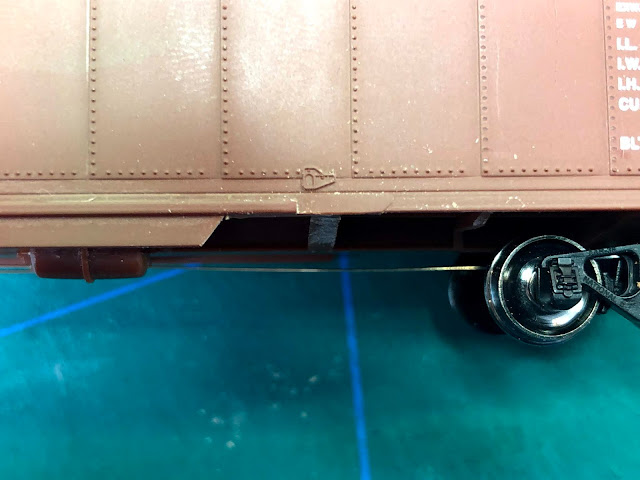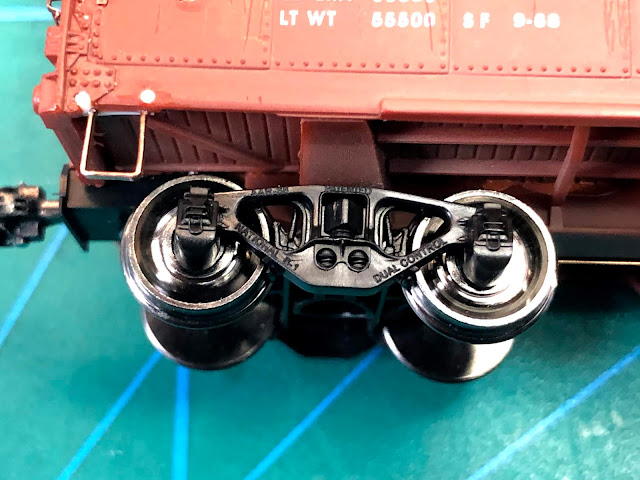The model as provided doesn't have an attachment for the running board laterals. They just float in mid air. To rectify this add short pieces of 0.010" x 0.030" styrene strip, bent into an 'L' and glued to the underside of the lateral and to the edge of the roof. I added a rivet to each which I harvested from an Athearn boxcar.
To detail the ends, drill and mount wire grabs and 1" nut bolt washer parts above them. The prototype bracket grab can be simulated with a Kadee grab by cutting one end off and mounting it 90 degrees on the inboard end. A small drop of CA will re attach the two halves of the grab together.
The next improvement is to correct the side sill. Remove 0.5" from the lower right hand side of the sill reinforcement. Then cut it on a 45 degree angle. Follow this by extending the left end of the sill reinforcement by 0.5" with a piece of 0.040" by 0.080" styrene. Taper the end of it by 45 degrees also.
The running board end supports are fairly crude, so I created new ones from 0.010" x 0.030" styrene and a couple of harvested rivets. Next I installed an etched brake step and supports made from 0.010" x 0.030" styrene and harvested rivets again.
I carved off the brake housing and installed an Ajax uint from Tichy along with a Kadee brake wheel. Lastly the retainer valve pipe has been replaced with 0.008" wire to represent the 3/8" NPT pipe used on the prototype.
The prototype has bottom mount sill steps. Installing A line sill steps is a simple upgrade that not only matches those used on the prototype, but they are much more durable. The left end uses a straight step while the right end uses a single angle step. The second view also shows the National B1 truck. Note of caution, the sides are very thin so add a piece of styrene behind the sill to thicken it so you can drill without breaking through.
The last easy upgrade is to add the upper door bits. In the middle add two pieces of styrene to make up an 'L' shape. First glue a piece of 0.010" x 0.040" flat against the track. Then add a pice of 0.020" x 0.020" along the bottom edge of the first piece. Finish up by adding four small pieces of 0.010" x 0.040" to represent the the small tabs at the top of each door.
I decided that this could be easily done with 0.005" styrene and both harvested rivets and Archer rivets. The Proto 2000 car has 4 panels to the right of the door and 7 to the right. The prototype has three to the left of the door and six to the right. The ones on the right use two different widths also. To begin the conversion use a chisel blade and remove all the rivets where the new panels go. Then sand the panel seams. Not every last bit needs to be removed. Then cut 0.005" thick styrene sheet into 0.600" strips and cut using a chopper to length. Apply the panels working from the inside of the car to the ends, maintaining the correct overlap. I word of caution on glue. Use very little and a really small brush. I prefer Tamiya Extra Fine " Quick Set". It is the least hot of all the styrene glues I have tried. It flashes off very quickly and doesn't smell as bad as MEK. Even with caution I still had a couple of glue sink marks. These were corrected with a bit of filler and wet sanding. The three panels to the right of the door were not replaced. I sand blasted the car before starting so the glue would not have to work though the paint.
I added door stops from my National Scale Car parts line, to replace those carved off in the panel replacement. Archers rivets are used on the panels edges and bottoms. Harvested rivets are used for the loading rack rivets in the middle of the panels and to detail the under frame attachment to the side sill. I had a spare set of ladders that I used for the sides as the originals were bent. The last detail is to add the Kadee bracket grabs to the left ends of the sides.
I need to source some decals for this car. A set exists for a 40' GTW Steel Car, but I may have to pull from a few sets to make up some of the data for this 50 footer.
I will show the final car in Part 3.

















































